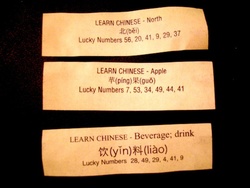祝你好运!
 In American Chinese restaurants, the standard "dessert" is a "fortune cookie" -- a thin, crisp shell inside which is placed a small slip of paper, usually containing an inspirational message of some sort (rather than any kind of prophecy). Sometimes on the reverse of the slip of paper there is a Chinese word or phrase, along with six "lucky numbers" from 1 to 60 (inclusive).
In American Chinese restaurants, the standard "dessert" is a "fortune cookie" -- a thin, crisp shell inside which is placed a small slip of paper, usually containing an inspirational message of some sort (rather than any kind of prophecy). Sometimes on the reverse of the slip of paper there is a Chinese word or phrase, along with six "lucky numbers" from 1 to 60 (inclusive).
If you were to open three fortune cookies, the expected number of distinct lucky numbers you'd get can be written as b a , where a and b are positive coprime integers. Find a + b .
Details and assumptions
- Just as an example, the three fortunes pictured have 13 distinct lucky numbers.
- The lucky numbers are distributed uniformly.
- The six numbers on each fortune are distinct.
The answer is 863.
This section requires Javascript.
You are seeing this because something didn't load right. We suggest you, (a) try
refreshing the page, (b) enabling javascript if it is disabled on your browser and,
finally, (c)
loading the
non-javascript version of this page
. We're sorry about the hassle.
3 solutions
Hey I did the same thing :) ...
Matt Enlow: Thanks for the luck :)
Nice. Short and sweet.
Let the set of numbers on the fortune cookies be F 1 , F 2 , and F 3 . For now, we seek the expected value of the cardinality of the intersection of F 1 and F 2 . Note that for each element in the set F 1 , there is a 1 0 1 chance that it is also in F 2 , because there are six elements in F 2 and 60 total numbers to choose from as a number on a fortune cookie. Then, as there are six elements in the set F 1 , the expected value of the cardinality of the intersection of F 1 and F 2 is 1 0 6 . This is also the expected value of the cardinality of the intersection of F 2 and F 3 , and also of F 3 and F 1 .
The expected value of the cardinality of the intersection of all three sets is, by similar logic, 1 0 0 6 . By the Principle of Inclusion and Exclusion and by the linearity of expectation, the expected number of distinct lucky numbers from opening three fortune cookies is 1 8 − 1 0 6 ⋅ 3 + 1 0 0 6 = 5 0 8 1 3 ⟹ a + b = 8 6 3 .
Please explain how the expected number of cardinality of intersection of F1 and F2 is 6 / 1 0
Log in to reply
I like the way he thought about it, though he could have given more details. (esp for the triple intersection).
Another approach is to use the linearity of expectation. The expected number of times that "1" appears in both sets is clearly 1 0 1 × 1 0 1 = 1 0 0 1 . Hence, the expected number of times that (a number from 1 to 60) appear is 1 0 0 6 0 = 1 0 6 . Then, for the triple intersection, the expected number is clearly 1 0 × 1 0 × 1 0 6 0 = 1 0 0 6 as claimed.
I think we have interpreted the problem differently. Can you clarify why my interpretation does not hold? Thanks. In my interpretation, since the problem states that the six numbers on a fortune cookie have to be distinct, once the first number is picked the set of numbers that we can choose from decreases to 59. Then, after the second number is picked, it decreases to 58. And so on. Therefore, when finding the expected cardinality of the intersection of two sets, don't we need to factor in the complication I've mentioned above?
Pretend you open 3 fortune cookies. The first fortune cookie gives you 6 distinct lucky numbers guaranteed . Then, the probability that you get 6 distinct lucky numbers from the second is (60-6)/60 6=5.4. Thus the expected value of lucky numbers at that point is 6+5.4=11.4. Then, repeating, we have (60-11.4)/60 6=4.86. Thus, the expected value total is 6+5.4+4.86=813/50 so 813+50=863
The probability that 1 does not appear on any fortune is ( 9 / 1 0 ) 3 = 7 2 9 / 1 0 0 0 , so the probability that 1 is among the lucky numbers is 2 7 1 / 1 0 0 0 . The same holds for each of the 60 possible lucky numbers, so by linearity of expectation the number of values from 1 to 60 which appear in some fortune is 6 0 ∗ 2 7 1 / 1 0 0 0 = 8 1 3 / 5 0 . The answer is 8 1 3 + 5 0 = 8 6 3 .